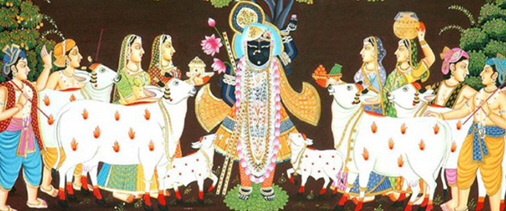The Shrinathji temple at Nathdwara celebrates, on an average, three festivals in a week. As regards to daily routine, the inner sanctum is opened 8 times a day for the devotees undertake sacred darshan of the deity. Very elaborate and complex rituals have emerged around the worship of Shrinathji due to confluence and inter-mixing of cult of Krishna as well as that of Pushti Margi Shri Vallabhacharya. The main attractions of Shrinathji are the Aartis and the Shringar, i.e. the dressing and beautifying of the deity of Shrinathji, treating it as a living child, adorning it with the appropriate dresses commensurate to the time of day or night. The formal prayers are offered with diya, flowers, fruit and other offerings, with local instruments and devotional songs of the Shrinathji, according to the demand of the time and occasion. The view of the deity after the parda (curtain) is removed is called jhakhi.
The priests in the Havelis of Shrinathji are believed to be from the kul (descendants) of Vallabhacharya, , the founder of this deity at Govardhan hill, near Mathura. Presently, Shrinathji is worshiped by priests from this kul (genealogical descendants) of Vallabhacharya, in all Havelis around the world, which have also been established exclusively by them. Devotees throng to the shrine in large numbers during occasions of Janmashtami and other festivals, like Holi and Diwali. The deity is treated like a living image, and is attended with daily normal functions, like bathing, dressing, meals called “Prasad” and the resting times in regular intervals. Since, the deity is believed to be a child form of Krishna, special care is taken and attention is given to the deity.


The sequence of eight darshans are set out below.
- Mangala: First darshan of the day. Lord, having woken up, has just had his breakfast and greets his devotees with the most “auspicious” darshan of the day. This darshan usually occurs at dawn.
- Shringar: Having bathed and dressed her little darling, Mother Yashoda allows everyone to adore her baby. After this darshan, the Lord goes out to play with his friends.
- Gval: Having had his mid-morning snack, the Lord is about to go out to herd the cows of Nandaji. Lord is worshipped by reciting His thousand names and the sacred tulsi (basil) leaves are offered with each name.
- Rajbhog: After his mid-day meal, the Lord is resting in the comfort of Nanadalay. Lord is often most regal and resplendent for this darshan. Fresh garlands and lotuses are offered to the Lord. The arti, Lord plays chopat, an ancient board game or version of chess to while away the hot afternoon.
- Utthanpan: Lord has just woken up from his afternoon siesta.
- Bhog: Having had his afternoon snack, the Lord is about to go out to play again.
- Sandhya: As the sun dips over the western horizon, the Lord returns with the herds of Nandaji and the gopies come to see their beloved. Mother Yashoda wards off any evil that may have befalled her darling in the woods of Vraj, by doing an arti and the Lord bathes for the evening meal.
- Shayan: Having had his dinner, the Lord is about to go off to his bed chamber. This is the last public darshan of the day.
The outline of darshans given above is a general layout. Over the centuries, different Goswamis have interpreted the “bhavas” and “lilas” differently, resulting in a mixture of oral and ritual traditions followed by the various havelies of Pushti Marg. For example, the Shrinathji, having left his beloved Vraj, misses it so dearly, that for six months of the year, he runs back to Vraj for the shayandarshan. So, from Mangala to Sandhyaarti, the Lord is reckoned to be in Nathadwara. After the arti, he rushes over, in his spiritual form, to play with the gopis of Vraj. Hence, Shayanarti takes place at Mount Govardhan for the warm half of the year. During the cold months, running over to Vraj is not such a practical option, and hence the shayandarshan takes place at Nathadwara. Here the bhava of gopijan’sviraha and Raasa-Rasika’s unique lila are of paramount importance.